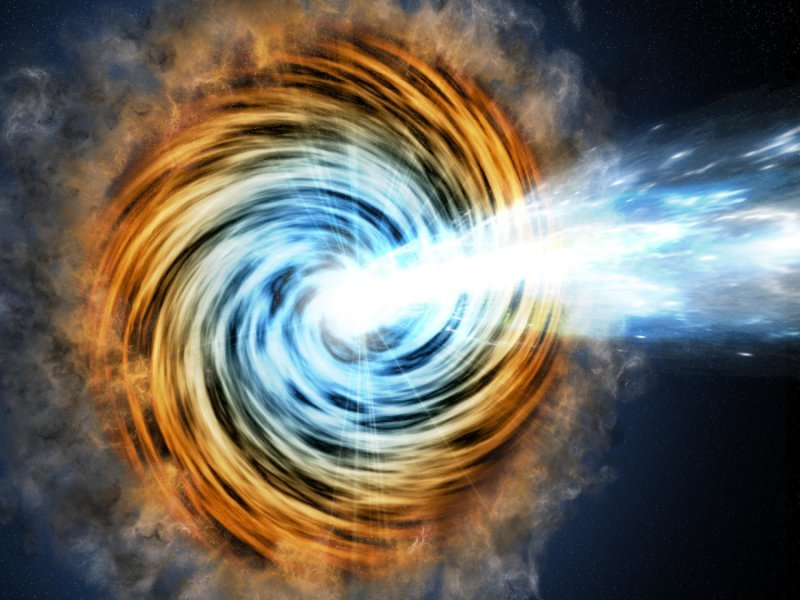High-Energy Gamma Rays From Super Powerful Blazar Studied By NASA’s Fermi Gamma-Ray Space Telescope
MessageToEagle.com – They are among the most fascinating cosmic phenomena. Astronomers know them as blazars and each of them harbors a supermassive black hole and jets emanating in opposite directions from near its poles.
These sources are unique evidence of the most extreme speeds and energies known in the extreme Universe.
Only one blazar would be enough to endanger our existence so it is good that none of them is located too close to our planet Earth.

High-energy gamma rays from super powerful blazar are now studied by NASA’s Fermi Gamma-ray Space Telescope.
“When we looked at all the data from this event, from gamma rays to radio, we realized the measurements told us something we didn’t expect about how the black hole produced this energy,” said Jonathan Biteau at the Nuclear Physics Institute of Orsay, France. He led the study of results from the Very Energetic Radiation Imaging Telescope Array System (VERITAS), a gamma-ray telescope in Arizona.
Astronomers had assumed that light at different energies came from regions at different distances from the black hole. Gamma rays, the highest-energy form of light, were thought to be produced closest to the black hole.

“Instead, the multiwavelength picture suggests that light at all wavelengths came from a single region located far away from the power source,” Biteau explained.
The gamma rays came from a galaxy known as PKS 1441+25, a type of active galaxy called a blazar. Located toward the constellation Boötes, the galaxy is so far away its light takes 7.6 billion years to reach us. At its heart lies a monster black hole with a mass estimated at 70 million times the sun’s and a surrounding disk of hot gas and dust.
If placed at the center of our solar system, the black hole’s event horizon — the point beyond which nothing can escape — would extend almost to the orbit of Mars.
In April, PKS 1441+25 underwent a major eruption and a team of researchers led by Luigi Pacciani at the Italian National Institute for Astrophysics in Rome, in collaboration with the Major Atmospheric Gamma-ray Imaging Cerenkov experiment (MAGIC), located on La Palma in the Canary Islands. began observations of the phenomenon.
Using public Fermi data, Pacciani discovered the outburst and immediately alerted the astronomical community. Fermi’s Large Area Telescope revealed gamma rays up to 33 billion electron volts (GeV), reaching into the highest-energy part of the instrument’s detection range. For comparison, visible light has energies between about 2 and 3 electron volts.
“Detecting these very energetic gamma rays with Fermi, as well as seeing flaring at optical and X-ray energies with NASA’s Swift satellite, made it clear that PKS 1441+25 had become a good target for MAGIC,” Pacciani said.
Following up on the Fermi alert, the MAGIC team turned to the blazar and detected gamma rays with energies ranging from 40 to 250 GeV.
“Because this galaxy is so far away, we didn’t have a strong expectation of detecting gamma rays with energies this high,” said Josefa Becerra Gonzalez, a researcher at NASA’s Goddard Space Flight Center in Greenbelt, Maryland, who analyzed Fermi LAT data as part of the MAGIC study. “There are fewer and fewer gamma rays at progressively higher energies, and fewer still from very distant sources.”
The reason distance matters for gamma rays is that they convert into particles when they collide with lower-energy light. The farther away the blazar is, the less likely its highest-energy gamma rays will survive to be detected.
VERITAS also detected gamma rays with energies approaching 200 GeV. The finding also provides insight into a phenomenon known as extragalactic background light (EBL), a faint haze of light that suffuses the universe. The EBL comes from all the stars and galaxies that have ever existed, and in a sense can track the history of the universe.
For more information about NASA’s Fermi, visit: www.nasa.gov/fermi
Research is published in The Astrophysical Journal Letters.
MessageToEagle.com
via NASA




![127 18 Share Email Home Astronomy & Space Astronomy FEBRUARY 28, 2022 Kilonova afterglow potentially spotted for first time by Amanda Morris, Northwestern University An artist’s conception illustrates the aftermath of a 'kilonova,' a powerful event that happens when two neutron stars merge. Credit: NASA/CXC/M. Weiss For the first time, Northwestern University-led astronomers may have detected an afterglow from a kilonova. A kilonova occurs when two neutron stars—some of the densest objects in the universe—merge to create a blast 1,000 times brighter than a classical nova. In this case, a narrow, off-axis jet of high-energy particles accompanied the merger event, dubbed GW170817. Three-and-a-half years after the merger, the jet faded away, revealing a new source of mysterious X-rays. As the leading explanation for the new X-ray source, astrophysicists believe expanding debris from the merger generated a shock—similar to the sonic boom from a supersonic plane. This shock then heated surrounding materials, which generated X-ray emissions, known as a kilonova afterglow. An alternative explanation is materials falling toward a black hole—formed as a result of the neutron star merger—caused the X-rays. Either scenario would be a first for the field. The study was published today (Feb. 28), in The Astrophysical Journal Letters. "We have entered uncharted territory here in studying the aftermath of a neutron star merger," said Northwestern's Aprajita Hajela, who led the new study. "We are looking at something new and extraordinary for the very first time. This gives us an opportunity to study and understand new physical processes, which have not before been observed." Hajela is a graduate student at Northwestern's Center for Interdisciplinary Exploration and Research in Astrophysics (CIERA) and in the Department of Physics and Astronomy in the Weinberg College of Arts and Sciences. On Aug. 17, 2017, GW170817 made history as the first neutron-star merger detected by both gravitational waves and electromagnetic radiation (or light). Since then, astronomers have been using telescopes around the world and in space to study the event across the electromagnetic spectrum. Using NASA's Chandra X-ray Observatory, astronomers observed X-ray emissions from a jet moving very close to the speed of light produced by the neutron star merger. Starting in early 2018, the jet's X-ray emission steadily faded as the jet continued to slow and expand. Hajela and her team then noticed from March 2020 until the end of 2020, the decline in brightness stopped, and the X-ray emission was approximately constant in brightness. This was a significant clue. "The fact that the X-rays stopped fading quickly was our best evidence yet that something in addition to a jet is being detected in X-rays in this source," said Raffaella Margutti, astrophysicist at the University of California at Berkeley and a senior author of the study. "A completely different source of X-rays appears to be needed to explain what we're seeing." The researchers believe a kilonova afterglow or black hole are likely behind the X-rays. Neither scenario has ever before been observed. "This would either be the first time we've seen a kilonova afterglow or the first time we've seen material falling onto a black hole after a neutron star merger," said study co-author Joe Bright, also from the University of California at Berkeley. "Either outcome would be extremely exciting." To distinguish between the two explanations, astronomers will keep monitoring GW170817 in X-rays and radio waves. If it is a kilonova afterglow, the X-ray and radio emissions are expected to get brighter over the next few months or years. If the explanation involves matter falling onto a newly formed black hole, then the X-ray output should stay steady or decline rapidly, and no radio emission will be detected over time. "Further study of GW170817 could have far-reaching implications," said study co-author Kate Alexander, a CIERA postdoctoral fellow at Northwestern. "The detection of a kilonova afterglow would imply that the merger did not immediately produce a black hole. Alternatively, this object may offer astronomers a chance to study how matter falls onto a black hole a few years after its birth." Explore further Astronomers find x-rays lingering years after landmark neutron star collision More information: The emergence of a new source of X-rays from the binary neutron star merger GW170817, arXiv:2104.02070 [astro-ph.HE] arxiv.org/abs/2104.02070 Journal information: Astrophysical Journal Letters , Astrophysical Journal Provided by Northwestern University Facebook Twitter Email Feedback to editors Featured Last Comments Popular Commercial floor cleaners found to produce as much aerosol pollution particles as public roads 6 HOURS AGO 0 New brown dwarf discovered with TESS 7 HOURS AGO 0 Bitcoin carbon emissions rise as mining moves to US and other countries 7 HOURS AGO 4 Experimental evidence for long-distance electrodynamic intermolecular forces 7 HOURS AGO 0 3D micromesh-based hybrid printing for microtissue engineering FEB 25, 2022 0 Ancient oxygen levels provide clues to the timing of life and death on Earth 50 MINUTES AGO Climate change is causing high tree mortality in southern Amazon 52 MINUTES AGO Scaling laws in enzymes may help predict life 'as we don't know it' 53 MINUTES AGO Plastic labeling needs 'sustainability scale,' says new report 1 HOUR AGO Snail competition leads to fewer parasites that cause schistosomiasis 2 HOURS AGO Overlooked channels influence water flow and flooding along Gulf Coast 2 HOURS AGO Under pressure: A new theory helps predict when soft materials will fail 2 HOURS AGO Relevant PhysicsForums posts Standard way of expressing 'no proof given'? 1 HOUR AGO Really worried about the Ukraine 1 HOUR AGO Not getting anything in this subject Information system-: 1 HOUR AGO Is getting a Master's degree in physics worth it? 1 HOUR AGO Special Relativity violation via Quantum Mechanics? 1 HOUR AGO Kinematics - can't find the initial velocity according to the image 1 HOUR AGO More from Physics Forums | Science Articles, Homework Help, Discussion 1 2 Medical Xpress Medical research advances and health news Tech Xplore The latest engineering, electronics and technology advances Science X The most comprehensive sci-tech news coverage on the web Newsletters Email Science X Daily and the Weekly Email Newsletter are free features that allow you to receive your favorite sci-tech news updates in your email inbox Follow us Top Home Search Mobile version Help FAQ About Contact Science X Account Sponsored Account Archive News wire Android app iOS app RSS feeds Push notification © Phys.org 2003 - 2022 powered by Science X Network Privacy policy Terms of use 1 / 1An artist’s conception illustrates the aftermath of a 'kilonova,' a powerful event that happens when two neutron stars merge. Credit: NASA/CXC/M. Weiss](https://www.messagetoeagle.com/wp-content/uploads/2022/02/kilonova11-307x150.jpg)





